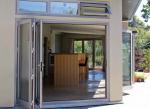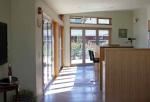A Home For All Seasons
By Graham Hepburn
Dave North is the first to admit that he and wife Ali weren’t “specifically looking for an eco house” when they built in Nelson but that’s kind of what they ended up with.
Rather, he and Ali just wanted a warm, dry and healthy home for themselves and their two children, aged 5 and 8. As Dave explains, “I’m used to the UK where houses are brick and have central heating and you can walk around inside with a T-shirt on, and Ali doesn’t like the cold.”
After seeing a couple of houses designed along passive solar principles by Helen Richards, of Powered Living, they approached her to come up with a plan for a home on a section they had already bought.
Helen says, “Although the urban site adjacent to the Maitai River had some design challenges - small size and with four neighbours in close proximity - it had a clear advantage in shape and orientation facing due north and elongated in east-west direction, virtually ideal for the design of a passive solar house.” The home has opposing roof planes with the north-facing side being higher and more open to the sun with a moderate pitch on the roof, whereas the south-facing side of the house has a much steeper roof pitch.
The main body of the house, consisting of an open plan kitchen/living/dining room on the north side, acts as the solar collector with heat stored in and then released from the concrete floors. The heat then moves back through the house and upstairs. The floors are insulated with polystyrene underneath and at the edges so that heat does not escape but is instead radiated back into the house.
Deeper stud framing – 140mm as opposed to the standard 90mm - has been used to accommodate upgraded insulation: R3 Batts in the walls and R5 in the ceilings. All the glass windows and doors are double glazed with the aluminium framing thermally broken to prevent heat loss. Ribbed Colorcote® has been used on the roof and for cladding because of its light and durable nature. Baby Corrugate has also been used to break up the look of the home.
Keeping the house warm is one thing, but care also has to be taken to make sure it doesn’t overheat. With that in mind, there is less glass on the western walls, while clerestory windows above the central corridor serve to provide a source of ventilation, as well as light.
Helen says, “Dave and Ali were really keen on a light corridor and they didn’t want too much glass at the rear because they have neighbours right behind them so we used clerestory windows to allow light to the centre and also rear of the house’ A rooflight at the top of the stairwell also provides more light and a
“ventilation chimney” for the house. Helen says the aim of the design was to keep the home within a comfortable temperature range, not dropping below 16C in
midwinter. At other times of the year a temperature of 19C is easily achieved.
”Due to the well insulated structure of the house, as heat migrates to the rear parts of the house and warms the cooler ambient temperature in those areas the rear masonry in turn responds and stores this heat,” says Helen. “This masonry includes a central feature spine concrete wall: ground aggregate concrete tilt panels which run right through the centre of the house.”
To boost the home’s capacity to collect and store solar heat, Helen included a Trombe wall. It consists of a sheet of double glazing mounted over a concrete panel that is fixed to the north face of the house and is 1.5 storeys tall so that it radiates heat into living area and the master bedroom upstairs. ”The idea of the Trombe wall is that a vertical surface will get more direct hits in winter and with the glass in front it amplifies the heat. The glass also insulates the concrete a little,” says Helen. “It’s an exaggerated version of a solar collector and it feels hot to the touch in winter.”
Helen has thermometers placed all over the house so she can monitor its performance throughout the year but how does it feel to live in? “Generally we’re very happy with it,” says Dave. “There’s absolutely no heating in the house at all.
As long as there’s sunshine the house is comfortable but if there’s continual cloud cover for a few days the house does cool down and you might have to put a jumper on. “We’ve got a couple of oil-filled heaters in the cupboard but we’ve never dragged them out and plugged them in.”
Not only do the family have no space heating, they also use only solar power for their hot water, which comes from a 300-litre cylinder. They had a back-up
immersion heater but when it malfunctioned Dave unplugged it and it’s never been reconnected. “We rely exclusively on solar water heating,” says Dave. “There would be half a dozen days in the year that the water gets slightly cool; otherwise we have plenty of hot water. The added bonus is having a power bill that is $50-$60 a month.” They also collect rainwater and that takes care of about 95 per cent of their water use – in the household and in the garden.
Dave says the clerestory windows help to stop the house overheating but they have to be opened and closed at the right times to maintain an optimum temperature. “You have to be a little bit careful to shut them when the outside temperature starts dropping,” says Dave. “Living in the house is a process of learning to manage the house to keep the temperature just right.”
Powered Living





